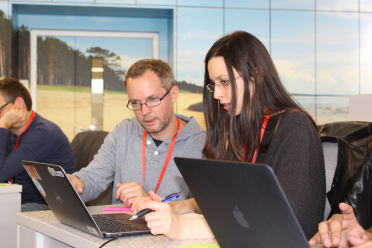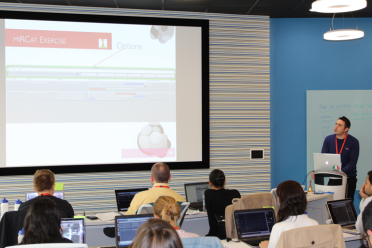Good things come in small packages: microRNA
We host our “miRNA Workshop 2016” to train early-career bioinformaticians from across the globe how to analyse small RNA data generated by next generation sequencing for both animal and plant research.
All cells within an organism carry the same genetic instructions but are clearly not equal. What makes a brain cell different from a skin cell is that different subsets of genes and their active proteins allow the cell to function correctly.
Gene expression is a complex process and can be regulated at several levels. One of the most recently discovered regulatory layers, called “RNA silencing,” involves microRNAs (miRNAs), tiny RNA (ribonucleic acid) molecules of only up to 22 nucleotides in length.
miRNAs play a crucial role in the RNA silencing machinery and can interact with messenger RNAs (mRNAs) by binding to complementary target regions. This interaction, which can be predicted using specialised computer algorithms, can block protein production and lead to the degradation or 'silencing' of the mRNA molecule.
“Discovering novel miRNAs and understanding which genes they silence is key to understanding complex regulatory and developmental processes in plants and animals, said Co-lead Trainer Dr Simon Moxon. “Misregulation of miRNA expression has been implicated in a wide variety of human diseases, including many forms of cancer and neurodegenerative conditions, so identifying these molecules and their biological targets is critical.”

The course, led by Dr Matthew Stocks (UEA) and Dr Simon Moxon (EI) studied the initial preparation of small RNA (sRNA) data including quality control and normalisation of genome samples.
This allowed the researchers to search for miRNA sequences and their respective targets, detection of differentially expressed sequences and building small RNA target interaction networks.
To conclude, the course focused on experimental design and how this can impact overall bioinformatics analysis strategies.
For the gene target prediction in mammals, mainly human and mouse biological data was used for the workshop, alongside Arabidopsis data for target prediction in plants. All of the course information is available online.
Dr Matthew Stocks from UEA’s School of Computing Sciences, said: “It is important that when asking that crucial question of ‘what did we sequence and how much of it’ that considerations be made about the quality of the input data, as well as the varying strategies that lead to bioinformatics products such as predictions on novel functional sequences and calls on their expression levels.
“I was extremely happy that the training attendees were keen to learn the underlying principles of this type of bioinformatics analysis, as well as how to perform these and, as such, making their screen look far less blank when it comes to applying these techniques in practice. The modern training facilities at EI provide a great learning environment and are well suited for teaching researchers of all levels this type of analysis.”
Alongside Dr Stocks and Dr Moxon, the scientific trainers were, Dr Irina Mohorianu, Mrs Claudia Paicu and Mr Thomas Bradley.

A member of Vincent Moulton’s Computational Biology group at UEA who has been part of a long-standing collaboration with members of Tamas Dalmay’s group in the School of Biological Sciences at UEA and EI Faculty to develop bioinformatics tools for the analysis of high-throughput small RNA-Sequencing data.
Dr Stocks’s current research involves producing small RNA data tools that are easy to use and accessible to users with a wide range of research backgrounds, in order to make them suitable for both real-data analysis and as a teaching aid. Particular attention has been paid to creating intuitive software interfaces and decreasing the level of system resources required for processing the extremely large datasets produced in modern sequencing experiments. He has also taken part in several studies of sRNA populations in human cancer cells and is currently investigating the role of miRNAs in bumblebee development pathways.
Project Leader in the Swarbreck Group (Organisms and Ecosystems) at EI, he has created algorithms and developed several complete bioinformatics tools for the discovery of miRNAs and their targets in plants and animals, as well as the study of general sRNA features. In addition, Dr Moxon works closely with experimentalists to study the role of miRNAs in a variety of organisms and biological processes.
His previous work has included the discovery of miRNAs involved in fruit ripening in tomato and a new class of small RNA in the pathogenic fungus Mucor circinelloides. His current research focus is the use of new technologies to understand miRNA function and improve computational miRNA target prediction.

At EI, as part of our next-generation sequencing facilities, we have established a pipeline for the construction and sequencing of small RNA libraries and worked across a number of species including crop and mammalian genomes.
We always welcome discussion with potential clients/collaborators at the planning stage to go through experimental design issues e.g. RNA extraction methods, sequencing depth and multiplexing level.
The development of protocols for the sequencing of micro/small RNAs has allowed researchers to investigate the roles that these molecules play in the genetic control of cell processes. Experiments can be designed to study tissue-specific and developmental expression patterns, disease associations and discovery of new microRNAs.
Find out more about our genomics services here.